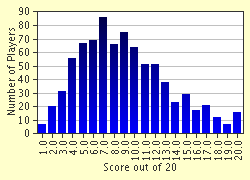Quiz Answer Key and Fun Facts
1. Brilliant author of the plan for invading western Europe. Commanded the 11th Army in the conquest of the Crimea in 1941, and led a gallant but vain attempt to extricate the Germans trapped at Stalingrad in 1942.
2. This German SS Officer performed several operations under orders from the RSHA, including the liberation of Mussolini in 1943 and the disguising of German troops as Americans in the Battle of the Bulge.
3. He led an army group in the invasion of Poland, went on to lead Army Group A in the invasion of France, after which he was transfered to Russia and given command of Army Group South. Except for a period in the summer of 1944, this man was commander in chief of the west front from 1942 to March 1945.
4. He wrote the tank strategician's Bible, 'Achtung Panzer'. Who was it?
5. He was appointed a field marshal in 1943, and served on the Russian front in 1944 and 1945. He later served as a member of the Doenitz government. Who was it?
6. This German field marshal commanded the Sixth Army that was forced to surrender at Stalingrad in 1943. He was taken prisoner by the Soviets. Who was it?
7. This man served as the chief of the general staff of the land armies from September 1942 to July 1944, he was responsible for the German offensive at Kursk.
8. This man was named head of the Oberkommando der Wehrmacht in 1938, and was notorious for following Hitler's orders no matter what the consequences. This caught up with him, as he was executed as a result of the Nuremberg Trials.
9. This man was a German general who supervised the destruction of Rotterdam in 1940 and Sevastopol in 1942.
10. This man served as the Reichskommisar of the Ukraine, and was responsible for the policy of exploitation and extermination in that region of the USSR.
11. This man commanded the German and Italian forces in North Africa from 1941 to 1943. He was charged with building the Atlantic Wall and commanding Army Group B in North-West Europe.
12. This German general succeeded in North Africa, and in March 1943 became commander-in-chief of the armies in Tunisia. His surrender ended the German participation in the North African theatre.
13. This SS general became a member of the Nazi party at its birth. Commander of the Fuehrer's personal SS bodyguard, he was appointed by Hitler to organize the Waffen-SS. He commanded an army corps on the Russian front, and participated in the Battle of the Bulge.
14. Here is a tough one- This man commanded the General Administration of Civil Police (Orpo, or Ordnungspolizei). An SS general, he took over as the executioner of Czechoslovakia after Heydrich's assassination.
15. This German field marshal commanded troops in Poland and France before his invasion of the Balkans, in which he conquered Greece. He was given command of Army Group A on the Russian front, but was dismissed from it in September of 1942.
16. A German general, this man was a commander of mountain troops. His division occupied and defended Narvik. In 1942-44, he was the commander of the German troops in Lapland
17. This man was appointed commander in chief of the German navy in 1933. He planned the invasion of Norway in 1940, but succeeded in convincing Hitler to shelve Operation Seeloewe. In 1943, he was replaced.
18. A German SS Colonel, this man's combat group of the 1st SS Panzer Division murdered several American prisoners near Malmedy on December 17, 1944.
19. This SS General who was ordered by Hitler to make an all-out counterattack on the Russians in the southern Berlin suburbs on April 21st, 1945.
20. This man served as the commander of the very first Totenkopfverbaende unit, and the first commandant of the first concentration camp.
Source: Author
LeviathanKyle
This quiz was reviewed by FunTrivia editor
bloomsby before going online.
Any errors found in FunTrivia content are routinely corrected through our feedback system.

